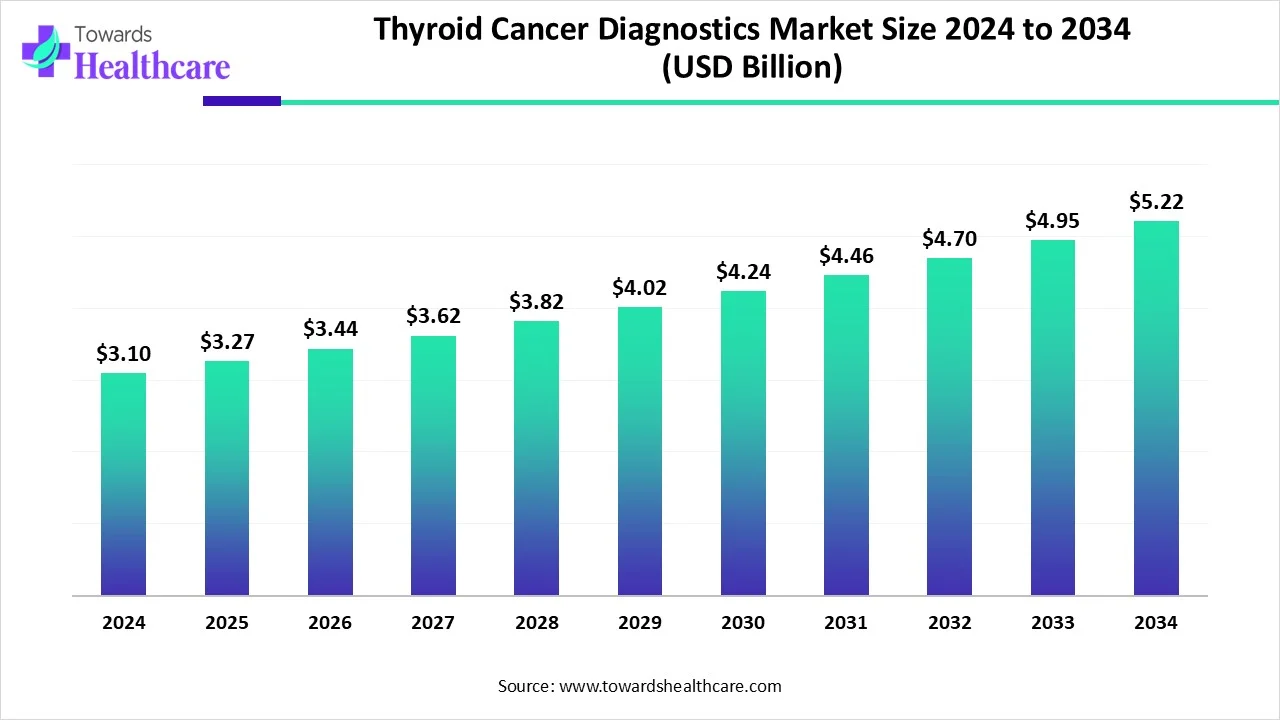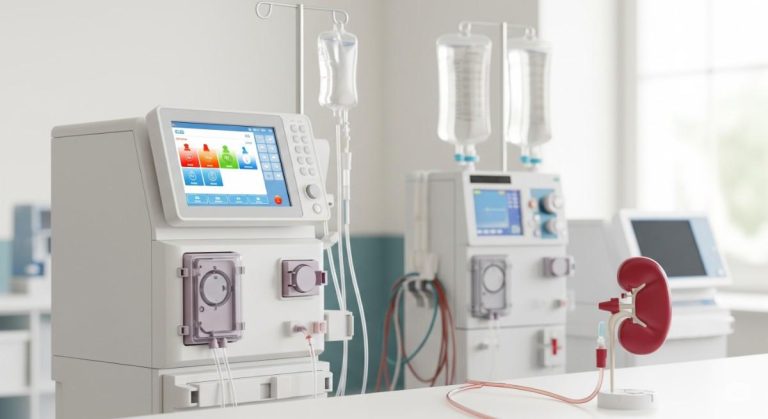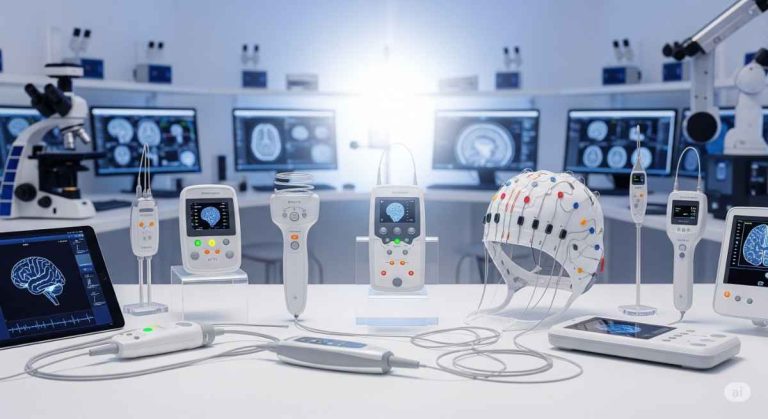
The global thyroid cancer diagnostics market is experiencing steady growth as advancements in medical technologies continue to enhance early detection, accurate staging, and personalized treatment options. According to recent market projections, the industry, valued at USD 3.1 billion in 2024, is expected to reach USD 5.22 billion by 2034, growing at a CAGR of 5.34% over the next decade.

Key Market Highlights
-
Market Size 2024: USD 3.1 billion
-
Projected Market Size 2034: USD 5.22 billion
-
Forecasted CAGR (2025-2034): 5.34%
-
North America Market Share (2024): 44%
-
Fastest Growing Region: Asia Pacific
Invest in Our Premium Strategic Solution: https://www.towardshealthcare.com/download-databook/5722
Market Overview: A Shift Towards Precision Diagnostics
The growing adoption of advanced diagnostic technologies is reshaping the thyroid cancer diagnostics market. Healthcare providers now rely on a combination of blood tests, physical examinations, biopsies, and imaging techniques such as CT, PET, and MRI scans to ensure early and accurate detection.
Thyroid cancer, which originates in the thyroid gland, often progresses silently, with symptoms such as voice changes, neck swelling, and swallowing difficulties emerging only in later stages. Early diagnosis plays a critical role in improving treatment outcomes and patient prognosis. Molecular testing, a cutting-edge advancement, is being increasingly used to analyze DNA, RNA, and protein biomarkers to detect mutations linked to thyroid cancer.
Key Market Trends Shaping the Future
AI-Powered Diagnostic Innovations
Artificial intelligence is playing an increasingly prominent role in thyroid cancer diagnostics:
-
University of Hong Kong Breakthrough (May 2025): Researchers developed a Named Entity framework utilizing large language models to extract staging and risk classification data from clinical notes with over 90% accuracy. (Source: The Pathologist)
-
HKUMed AI Model (April 2025): This AI-powered model delivers 90% diagnostic accuracy while significantly reducing consultation preparation time for clinicians by approximately 50%, supporting government initiatives to integrate AI in healthcare. (Source: ecancer)
Get All the Details in Our Solutions – Access Report Preview: https://www.towardshealthcare.com/download-sample/5722
Strengthening Oncology Research in India
In 2025, India’s Union Minister of Health & Family Welfare inaugurated the 2nd AIIMS Oncology Conclave at the National Cancer Institute, AIIMS Jhajjar. This large-scale public-funded healthcare project aims to advance cancer care and research across India’s Institutes of National Importance (INIs). (Source: Ministry of Health and Family Welfare)
Market Drivers and Challenges
Driving Factors
Rising Incidence of Thyroid Cancer
The global rise in thyroid cancer cases is largely attributed to improved diagnostic capabilities, higher radiation exposure, and environmental carcinogens. Thyroid cancer remains the most common form of endocrine cancer, with its incidence increasing steadily over recent decades.
Advancements in Diagnostic Techniques
Continuous innovations in molecular diagnostics are enabling more accurate differentiation between cancer subtypes and improving treatment outcomes. Understanding the genetic and molecular mechanisms involved — such as the MAP kinase and PI3K/Akt pathways — is crucial for tailoring effective therapies.
Restraining Factors
High Diagnostic Costs
Advanced molecular tests, though highly effective, come with a hefty price tag. This presents financial challenges, especially in lower-income countries where healthcare costs are often borne out-of-pocket, limiting patient access to advanced diagnostics.
If you have any questions, please feel free to contact us at sales@towardshealthcare.com
Regional Insights: Why North America Leads the Market
North America commands a dominant 44% share of the global thyroid cancer diagnostics market. Several factors contribute to this leadership:
-
Health Awareness Campaigns: Programs like the CHANGE initiative focus on increasing cancer awareness, education, and early detection, while addressing racial and socioeconomic disparities.
-
FDA Approvals & Industry Innovations:
-
In March 2025, Exelixis, Inc. received FDA approval for its CABOMETYX drug for multiple cancer types, highlighting the region’s strong pharmaceutical pipeline. (Source: Exelixis)
-
Rising obesity rates, sedentary lifestyles, and processed food consumption further contribute to the growing incidence of thyroid cancer in the U.S., necessitating robust diagnostic solutions.
-
U.S. Thyroid Cancer Trends
In 2025, thyroid cancer is projected to be the ninth most common cancer among women in the United States, with approximately 44,020 new diagnoses expected.
Industry Developments and Recent Announcements
Strategic Partnerships and Acquisitions
-
RadNet, Inc. Acquisition (June 2025): Through its DeepHealth subsidiary, RadNet completed the acquisition of See-Mode Technologies, a global AI innovator in ultrasound imaging. (Source: DeepHealth)
-
Interpace Diagnostics Policy Update (April 2025): Medicare’s decision to discontinue reimbursement for PancraGEN highlights ongoing regulatory shifts. (Source: Nasdaq)
-
LisenID and Mayo Clinic Collaboration (April 2025): This partnership aims to develop advanced early cancer diagnostic tools by combining epigenetic imprinting technology with clinical expertise. (Source: BioSpace)
-
INIS Agreement Finalized (January 2025): INIS gained full control over its proprietary medical device intellectual property. (Source: Firstword Pharma)
Conclusion: A Promising Future for Thyroid Cancer Diagnostics
The thyroid cancer diagnostics market is on an upward trajectory, driven by technological advancements, increasing cancer incidence, and AI-powered innovations. While challenges remain, particularly regarding cost and accessibility, continued research and strategic partnerships are paving the way for more precise, affordable, and widely accessible diagnostic solutions in the years ahead.
Source : https://www.towardshealthcare.com/insights/thyroid-cancer-diagnostics-market-sizing






